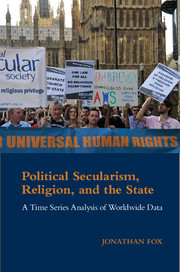Book contents
- Frontmatter
- Contents
- Acknowledgments
- 1 Introduction
- 2 Secularism or Secularization? The Secular-Religious Competition Perspective and Beyond
- 3 Establishment, Support, Neutrality, or Hostility: The Varieties of Official Religion Policy
- 4 State Support for Religion
- 5 Regulation, Restriction, and Control of the Majority Religion or All Religions
- 6 Religious Discrimination
- 7 Education, Abortion, and Proselytizing
- 8 Religion in Constitutions
- 9 Conclusions
- Appendix Data Collection and Reliability
- Bibliography
- Index
5 - Regulation, Restriction, and Control of the Majority Religion or All Religions
Published online by Cambridge University Press: 05 May 2015
- Frontmatter
- Contents
- Acknowledgments
- 1 Introduction
- 2 Secularism or Secularization? The Secular-Religious Competition Perspective and Beyond
- 3 Establishment, Support, Neutrality, or Hostility: The Varieties of Official Religion Policy
- 4 State Support for Religion
- 5 Regulation, Restriction, and Control of the Majority Religion or All Religions
- 6 Religious Discrimination
- 7 Education, Abortion, and Proselytizing
- 8 Religion in Constitutions
- 9 Conclusions
- Appendix Data Collection and Reliability
- Bibliography
- Index
Summary
Thomas Beckett became archbishop of Canterbury in 1162 with the support of King Henry II, who hoped that Beckett, who was until then the king's close advisor and chancellor, would use his position to support the king's rule and prerogatives. This did not prove to be the case, and Beckett sought to defend and expand the power of his religious office. This lack of control led Henry to wish Beckett dead. While there is no agreement on his exact words, many claim they were: “Will no one rid me of this turbulent priest?” This led directly to Beckett's assassination. Henry II is neither the first nor the last head of state to try and limit religion's political power. This chapter focuses on contemporary policies that regulate, restrict, and control religion.
The previous two chapters wrestled with the issue of whether supporting religion also implies an element of control and, if so, to what extent. The discussion in this chapter is free of this conundrum. It is certainly arguable that it is not possible to support religion without an element of control coming into play. However, there is little doubt that a state can have policies that control, restrict, and regulate religion without supporting it. This chapter focuses on this aspect of state religion policy. The 29 specific policies examined in this chapter are all examples of policies that focus on regulating, restricting, or controlling religion within the state and do not imply support for religion.
Of course, in the larger picture, control rarely exists without support. As demonstrated in Chapter 4, all states in this study save South Africa support religion in at least some small way. Thus, all of the 146 (82.5%) states that restricted, controlled, and regulated religion in 2008 also supported it. This finding that no state regulates, controls, or restricts religion without also supporting it in at least some small way is perhaps the most surprising and interesting finding in this chapter.
- Type
- Chapter
- Information
- Political Secularism, Religion, and the StateA Time Series Analysis of Worldwide Data, pp. 105 - 135Publisher: Cambridge University PressPrint publication year: 2015



